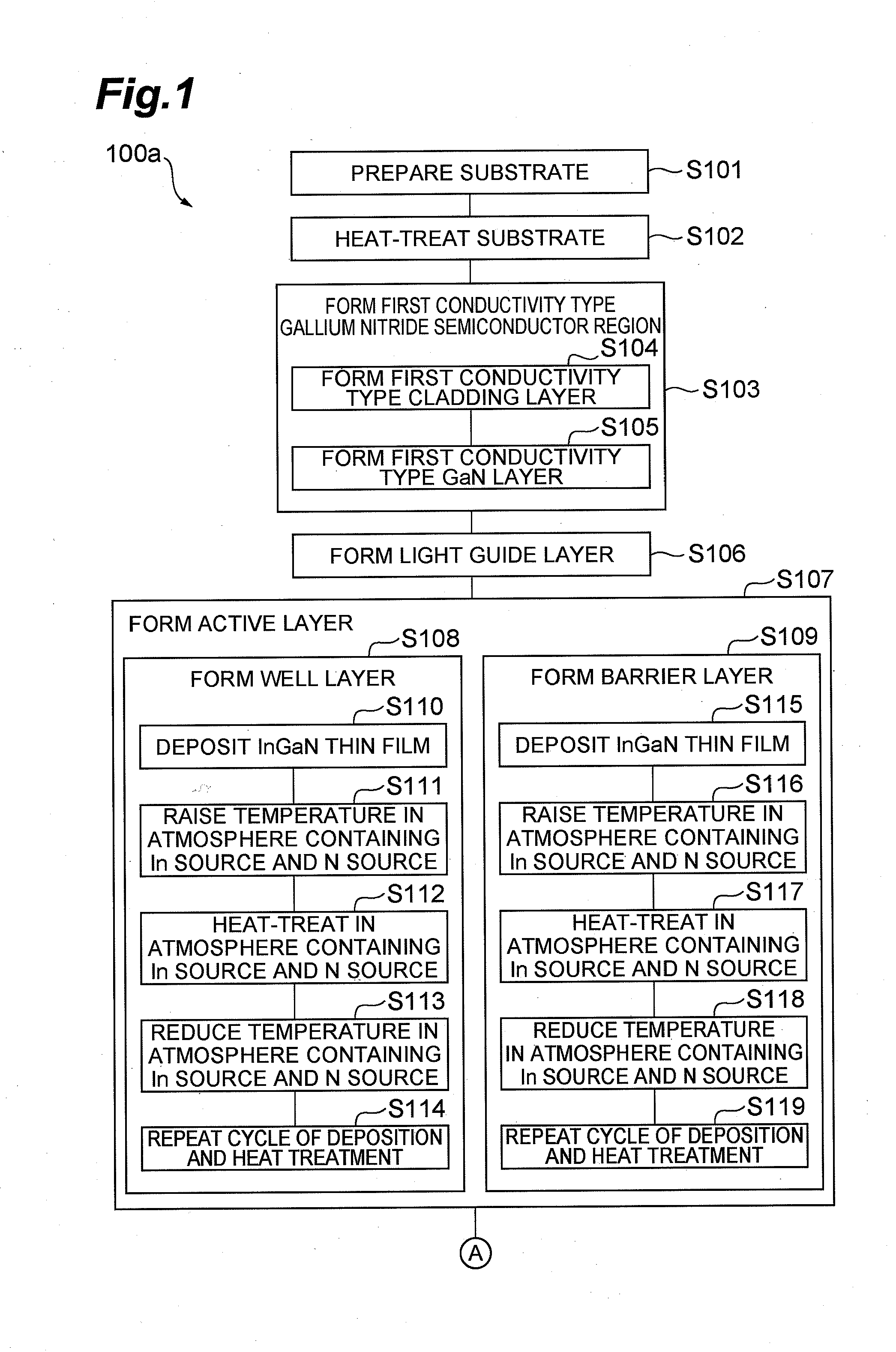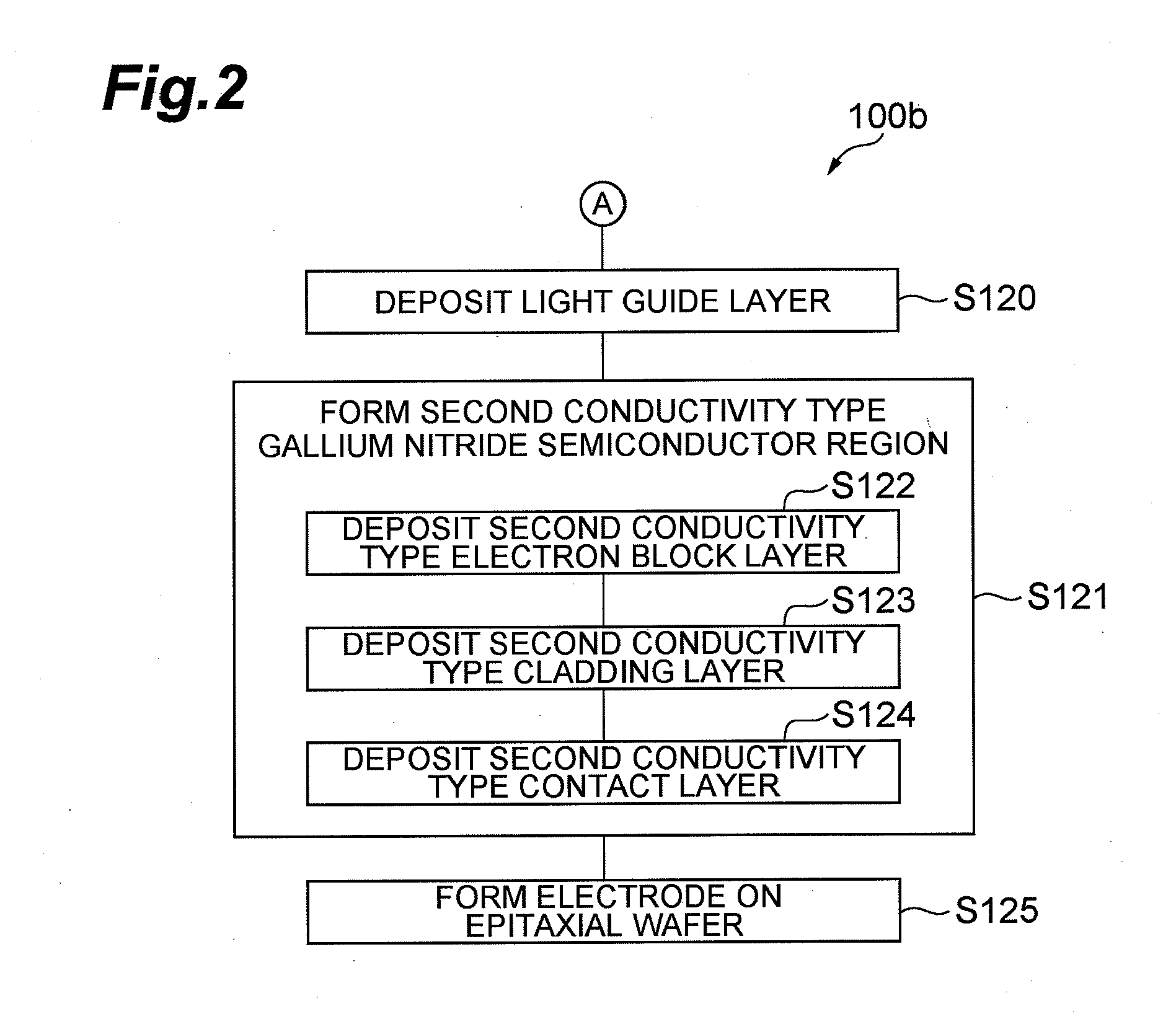Method of making nitride semiconductor laser, method of making epitaxial wafer, and nitride semiconductor laser
a semiconductor laser and epitaxial wafer technology, applied in the field of making nitride semiconductor lasers, epitaxial wafer making methods, and nitride semiconductor lasers, can solve the problems of large amount of laser oscillation threshold current, increase of non-mission parts in ingan well layers, and increase of indium content, so as to reduce the crystal quality of ingan well layers and reduce the effect of indium content and low emission efficiency
- Summary
- Abstract
- Description
- Claims
- Application Information
AI Technical Summary
Benefits of technology
Problems solved by technology
Method used
Image
Examples
example 1
[0089]A group III nitride semiconductor laser was fabricated on the c-plane of a GaN wafer as described in the embodiments above, with the exception of the formation of an active layer. The growth temperature was changed using a resistive heater of a susceptor. FIG. 7 illustrates the primary steps of forming the active layer for the group III nitride semiconductor laser in Example 1. In Step 207, the active layer was formed by the method illustrated in FIG. 7 through organometallic vapor phase epitaxy. After an In0.30Ga0.70N well layer having a thickness of 3 mn was grown at 700° C., in Step 209, an In0.06Ga0.94N barrier layer was grown. First, in Step 210, the In0.06Ga0.94N thin film having a thickness of 1 nm was deposited at 700° C. After the deposition of the thin film, in Step 211, the growth temperature was changed to 850° C. in two minutes, while TMIn and NH3 were supplied to the reactor. In Step 212, the growth temperature remains unchanged at 850° C. for one minute. After k...
example 2
[0091]A group III nitride semiconductor laser was fabricated on the c-plane of a GaN wafer as described in the embodiments above, with the exception of the formation of an active layer. The growth temperature was changed using an infrared lamp heater of a susceptor. The infrared lamp required only 10 to 30 seconds for temperature rise from 700° C. to 850° C. and temperature fall, whereas a resistive heater required about three to five minutes therefor. FIG. 8 illustrates the primary steps of forming the active layer of the group III nitride semiconductor laser in Example 2. In Step 308, the active layer was formed. First, in Step 310, an In0.30Ga0.70N thin film having a thickness of 1 nm was deposited at 700° C. After the deposition of the thin film, in Step 311, the growth temperature was changed to 850° C. in about ten seconds, while TMIn and NH3 were supplied to the reactor. In Step 312, the growth temperature was kept at 850° C. for about ten seconds. Then, in Step 313, the grow...
example 3
[0093]A group III nitride semiconductor laser was fabricated on a semipolar surface of a GaN wafer in the manner as described in the embodiments above, with the exception of the formation of an active layer, and the semipolar surface is tilted with reference to the c-plane by 21 degrees toward the direction of the a-axis. The growth temperature was changed using an infrared lamp heater of a susceptor. FIG. 9 illustrates the primary steps of forming the active layer of the group III nitride semiconductor laser in Example 3. In Step 407, an active layer was formed. First, in Step 410, an In0.30Ga0.70N thin film having a thickness of 1 nm was deposited at 670° C. After the deposition of the thin film, in Step 411, TMIn and NH3 were supplied to the reactor, while the growth temperature was changed to 850° C. in about ten seconds. In Step 412, the growth temperature was kept at 850° C. for about ten seconds. After keeping the temperature, in Step 413, the growth temperature was changed t...
PUM
| Property | Measurement | Unit |
|---|---|---|
| angle | aaaaa | aaaaa |
| temperature | aaaaa | aaaaa |
| temperature | aaaaa | aaaaa |
Abstract
Description
Claims
Application Information
 Login to View More
Login to View More - R&D
- Intellectual Property
- Life Sciences
- Materials
- Tech Scout
- Unparalleled Data Quality
- Higher Quality Content
- 60% Fewer Hallucinations
Browse by: Latest US Patents, China's latest patents, Technical Efficacy Thesaurus, Application Domain, Technology Topic, Popular Technical Reports.
© 2025 PatSnap. All rights reserved.Legal|Privacy policy|Modern Slavery Act Transparency Statement|Sitemap|About US| Contact US: help@patsnap.com



